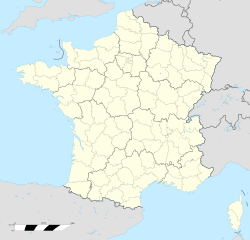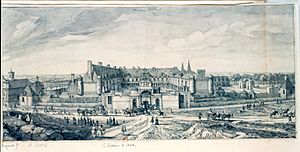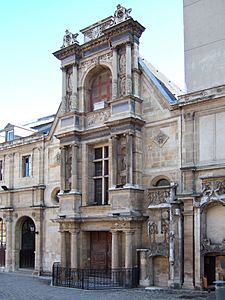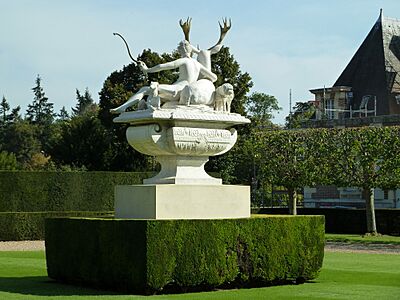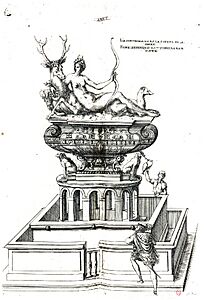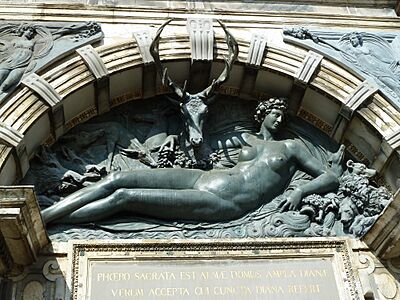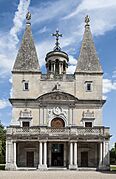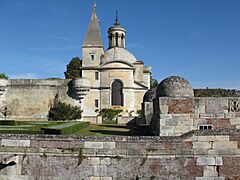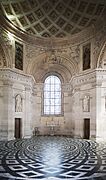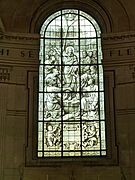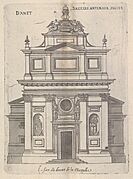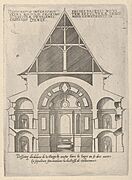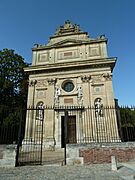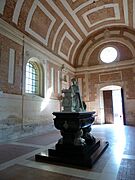Château d'Anet facts for kids
Quick facts for kids Château d'Anet |
|
|---|---|
| Anet, Eure-et-Loir, Centre-Val de Loire, France | |
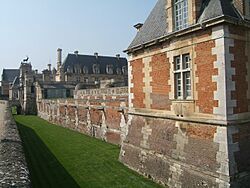 |
|
| Coordinates | 48°51′31″N 1°26′18″E / 48.85861°N 1.43833°E |
| Type | château |
| Site information | |
| Site history | |
| Built | 1549 |
The Château d'Anet is a beautiful old castle located near Dreux in France. It was built between 1547 and 1552 by a famous architect named Philibert de l'Orme. The castle was made for Diane de Poitiers, who was a close friend of King Henry II of France. It stands on the land that belonged to Diane's late husband, Louis de Brézé. He was an important leader in Normandy.
The Château d'Anet is famous for its amazing outside design. You can see the Fountain of Diana, which is a statue of Diane de Poitiers shown as Diana, the Roman goddess of the hunt. There is also the Nymph of Anet, a special carving by Benvenuto Cellini above the main entrance. Anet was one of the first places in France to have Italian-style gardens called parterres. These gardens were designed to be a beautiful part of the castle's front.
Contents
History of the Château d'Anet
How the Castle Began
The Château d'Anet was built on the old foundations of an even older castle. This older castle had been taken apart by King Charles V. Later, it was rebuilt as a manor house using bricks and stones. The name "Anet" comes from Simon d'Anet, who owned the land in the 1100s. In 1444, King Charles VII gave the land to Pierre de Brézé. This was a reward for Pierre helping to remove the English from Normandy.
Diane de Poitiers' Castle
Diane de Poitiers' castle was built from 1548 to 1552. It had three main courtyards. The Cour d'honneur was the main courtyard in the middle. The kitchens were on the right side. On the left side, there was an Orangerie (a place to grow orange trees) and a building called the Gouvernement. This building was where the estate's manager lived. It also held the Chambre de Trésor, which was like a treasury for important family documents.
Beyond the main castle, there were formal gardens. These gardens were square and divided into different sections. They were surrounded by covered walkways. On the north side, there was a special bathhouse. To the northeast, near the stables, was the Hôtel-Dieu. This was a place where sick servants and other people from the estate could get care. On the west side, there was Diane's private chapel for burials, along with an aviary (for birds) and a heronry (for herons).
-
A copy of Benvenuto Cellini's carving, the Nymph of Anet, above the entrance
The Castle's Chapel
The chapel at Anet, which now stands alone, was built between 1549 and 1552. It was originally connected to the east side of the main courtyard. The chapel has a unique design, shaped like a Greek cross with a dome above it. The dome has a special pattern of squares. The original entrance was from the courtyard, but that part of the castle was later taken down.
The chapel has a porch with tall, paired columns. These columns are in the Ionic order style. The towers on either side of the porch have pointed, pyramid-shaped tops. The beautiful stained-glass windows were made around 1904 by Charles Lorin from Chartres.
- Photos of the chapel as it exists today
The Mortuary Chapel
There is also a special mortuary chapel at Anet. This chapel was built following Diane de Poitiers' wishes to hold her tomb. Her daughter, the Duchesse d'Aumale, hired Claude de Foucques to build it. In 1581, King Henri III and his mother Catherine de' Medici visited this chapel. They came to attend the baptism of the baby son of Charles, duc d'Aumale.
- Designs for the mortuary chapel published by Jacques Androuet du Cerceau in 1579
- Photos of the mortuary chapel ( {{coord|48.858326|1.437370|scale:2000|display=inline}} )
Later Owners and Changes
In 1576, Diane's daughter, Louise de Brézé, gave the castle to her son, Charles, Duke of Aumale. Charles built a convent nearby in 1587. Later, Charles was involved in a plot against King Henry IV. He had to leave France in 1595. Because of this, a court in Paris ordered that he be put to death and all his property taken away. They even said the Château d'Anet should be destroyed.
However, King Henry IV stepped in and saved the castle. In 1610, Charles had many debts and went bankrupt. One of the people he owed money to, Marie of Luxembourg, Duchess of Penthièvre, claimed the castle. Her ownership was confirmed in 1615. The castle then passed to Marie's daughter, Françoise de Lorraine, Duchess of Vendôme, and her husband, César de Vendôme. César was an illegitimate son of King Henry IV.
The castle was later owned by Louis Joseph, Duke of Vendôme. He loved the château and often hosted grand parties there for his friends. Famous poets like Guillaume Amfrye de Chaulieu visited. Louis Joseph made many changes to the castle, removing some of its original Renaissance features. Only Diane's bedroom was left untouched. An extra floor was added to the main building to create more rooms. The gardens, which had been neglected, were destroyed. André Le Nôtre, a famous garden designer, was hired to create new parkland. The old galleries, bathhouse, orangerie, aviary, and heronry were all taken down. The stables and Hôtel-Dieu were also moved to new locations to make way for canals. These canals fed two windmills.
In 1686, the Grand Dauphin (the king's son) visited Anet for eight days. Louis-Joseph entertained him lavishly. The parties cost so much money that Louis XIV only allowed his son to visit again if he paid for the expenses himself.
The castle later belonged to many of Louis XIV's descendants. Louise-Françoise de Bourbon died there in 1743. Her father was the Duc du Maine, another illegitimate son of Louis XIV. His sons, the prince des Dombes and comte d'Eu, lived there when they were away from Versailles. Later, the very wealthy duc de Penthièvre owned it.
The French Revolution and Restoration
The Château d'Anet was not completely destroyed during the French Revolution. However, Diane de Poitiers' remains were moved to a simple grave. The castle's valuable contents, which belonged to King Louis XVI's cousin, were sold off. A large part of the castle was later taken down. But Alexandre Lenoir managed to save some important architectural pieces. These pieces are now in the École des Beaux-Arts in Paris.
The castle was in very bad shape, but a man named comte Adolphe de Riquet de Caraman bought it in 1840. He started a huge project to restore it. Because of money problems, Caraman sold the castle in 1860 to Ferdinand Moreau. Moreau continued the restoration work. He bought furniture and artworks that were believed to have originally been in the castle. A special set of tapestries made for the castle, showing the "History of Diana," is now spread out in different places. These tapestries were made to honor Diane de Poitiers.
In 1889, the French government officially recognized the château as a protected monument historique, which means it's a national heritage site.
The castle has also been used in movies! It was a filming location for the 1965 James Bond film Thunderball and the 1976 film The Pink Panther Strikes Again. The entrance of the Château d'Anet even inspired the design of a building in Philadelphia called the Guild House for the Elderly, built in 1966.
Images for kids
See also
- List of châteaux in Eure-et-Loir


